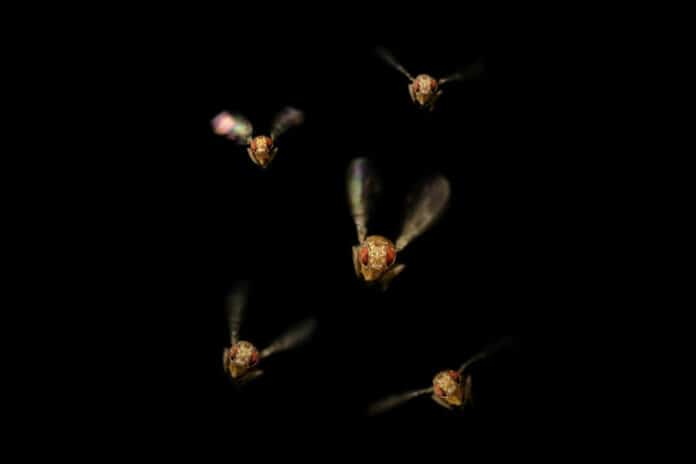Insects are the largest group of animals on Earth, with over a million species. Their success is due to their small body size and ability to fly, which provide access to unutilized niches and rapid translocation.
However, aerodynamic and space constraints require high wingbeat frequencies and miniaturization of the central nervous controllers for flight.
Researchers at Humboldt-Universität zu Berlin and Johannes Gutenberg University Mainz have worked together to solve a mystery that has confounded experts for many years.
They have identified the type of electrical activity that regulates insect flight in the nervous system.
They describe a previously unreported role of the electrical synapses used by fruit flies during flight in research recently published in Nature.
Fruit flies Moving forward require about 200 wingbeats per second for the Drosophila melanogaster, while other tiny insects can reach 1,000. The high frequency of wingbeats produces the irritating high-pitched buzzing sound that we typically associate with mosquitoes.
Due to their small bodies, insects must beat their wings at a specific frequency to avoid becoming “stuck” in the air, which behaves as a viscous medium. They adopt a clever strategy that is common among insects to achieve this.
The antagonistic muscles that raise and depress the wings are activated through reciprocal stretching in this way. High-frequency oscillation of the system can result in the rapid wingbeat rate needed for propulsion.
Each motor neuron produces an electrical pulse that regulates the wing muscles approximately every 20th wingbeat since it is impossible for them to keep up with the speed of the wings. These pulses are perfectly timed to other neurons’ activity.
The motor neurons that control the frequency of the wingbeat produce unique activity patterns. Although they do not fire simultaneously, all neurons fire at a regular rate. Each of them fires at regular, predetermined intervals. Although fruit fly brain activity patterns of this type have been observed since the 1970s, the underlying regulating mechanism has never been fully understood.
The researchers have discovered the puzzle’s answer, which is controlled by a tiny circuit of just a few synapses and neurons. This may apply to more species than just fruit flies.
According to Professor Carsten Duch of JGU’s Faculty of Biology, “A miniaturized circuit solution that only consists of a very few neurons and synapses controls wing movement in the fruit fly Drosophila melanogaster. And, likely, this does not apply to fruit flies alone.”
The researchers hypothesize that the more than 600,000 known species of insects that rely on a similar method of propulsion also employ a neural circuit of this kind.
Drosophila melanogaster is the ideal subject for research in neurobiology as it is possible to manipulate the various components of its neural circuit genetically.
Just two examples include the ability to directly affect the activity of individual neurons and switch individual synapses on and off. In this case, the researchers combined different genetic methods to assess the electrical characteristics and activity of the circuit’s neurons.
As a result, they were able to pinpoint each and every brain circuit cell and synaptic contact that contributes to the creation of flight patterns. They consequently discovered that the neural network controlling flight is made up of just a tiny number of neurons and exclusively uses electrical synapses for communication.
The researchers used various genetic methods to evaluate the electrical characteristics and activity of the neurons in the circuit. They discovered that the brain network controlling flight is made up of just a few neurons that can only connect via electrical synapses.
Scientists have demonstrated that such a sequential pulse creation distribution can occur even when brain activity is directly controlled electrically, absent of neurotransmitters.
The Mainz and Berlin-based team investigated the theoretical claim that merely electrical transmission between neurons would result in a pattern of sequential firing. Specific ion channels in the network’s neurons were altered to test this theory, and the flying circuit’s activity pattern synced.
The power generated during flying varied significantly as a result of this experimental adjustment. The team’s findings are especially startling given that it was previously considered that electrical synapses resulted in the synchronized firing of neurons.
The activity pattern formed by the electrical synapses discovered here suggests that the nervous system may be processing information in ways that are currently unknown.
A similar mechanism could work in thousands of other insect species and the human brain, where the function of electrical synapses is yet unknown.
The study was funded by German Research Foundation.
Journal Reference:
- Hürkey, S., Niemeyer, N., Schleimer,etal. Gap junctions desynchronize a neural circuit to stabilize insect flight. Nature. DOI: 10.1038/s41586-023-06099-0
